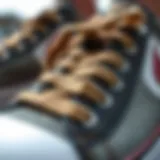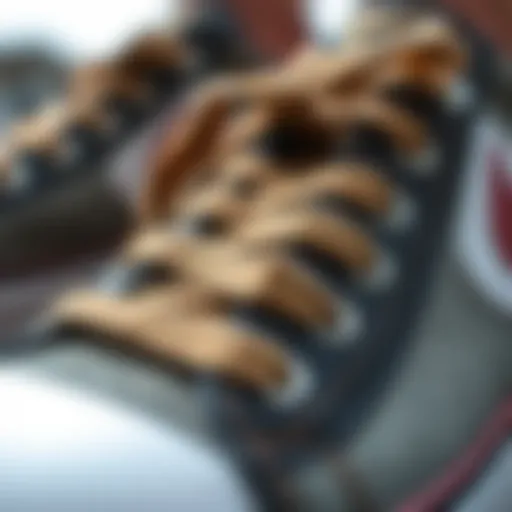Mastering Skateboarding: A Comprehensive Guide
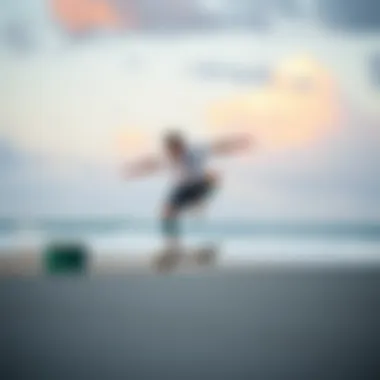
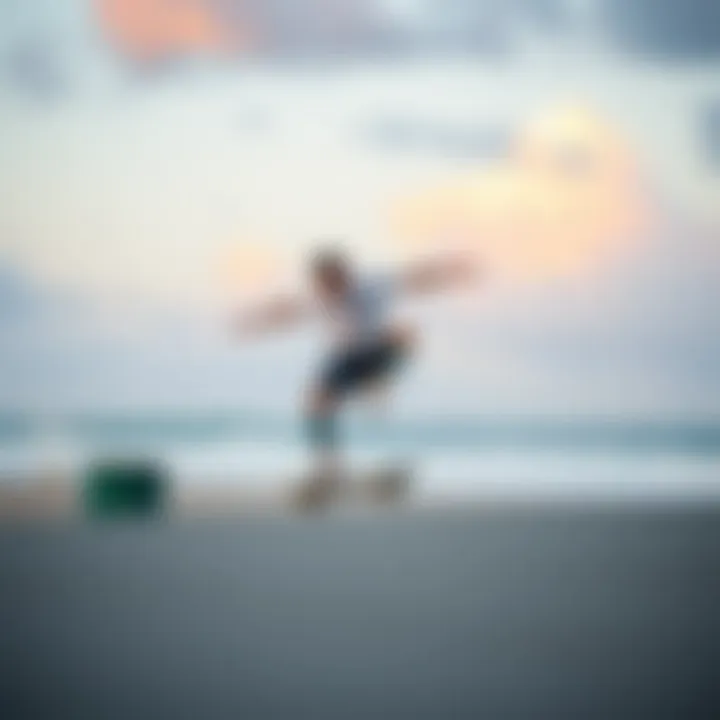
Intro
Skateboarding is more than just a way to get from Point A to Point B; it's an entire culture, a method of expression, and a test of balance and skill. For many, the allure of gliding over asphalt or performing tricks captures the spirit of freedom and exhilaration. This article serves as a guide for those who want to venture into the world of skateboarding. Here, we're going to break down the essentials that every beginner should consider—from the critical gear to essential skills. We'll touch on the setbacks many face while learning and even the psychology behind building the courage to push off.
As you take the plunge into skateboarding, understanding what you’ll need in terms of equipment is crucial. Good gear can make the difference between a smooth ride and a precarious tumble.
Skate Gear and Equipment
Crucial Skateboard Components
Skateboards come in various shapes and sizes, catering to different styles of riding. At the heart of your skateboard is the deck—typically made from laminated wood layers—designed for durability and performance. Choosing a deck suited to your body type and riding style is as essential as picking out a trusty pair of shoes for a long run. Below are some of the key components to consider when selecting your board:
- Deck: Look for a size that feels comfortable and provides stability. A wider deck offers more balance, while a narrower one is great for tricks.
- Trucks: These metal pieces allow your board to turn and maneuver. The weight and width of the trucks should align with the deck size.
- Wheels: Softer wheels provide a smoother ride on rough surfaces, while harder wheels are better for smooth skate parks but can feel jarring on imperfect terrain.
- Bearings: Good bearings ensure your wheels spin freely, affecting your overall speed. Opt for higher ABEC ratings for better performance.
Safety Gear: Protecting Yourself on the Board
Never overlook the importance of safety gear. Learning to balance on a skateboard can lead to some wobbly moments. Wearing appropriate protective equipment can safeguard you against injuries as you figure out the ropes. Here’s a checklist:
- Helmet: A high-quality skateboard helmet can save your head in case of a fall. Check for safety certifications to ensure maximum protection.
- Wrist Guards: These can prevent wrist injuries caused by falls, which are common when learning new tricks.
- Knee and Elbow Pads: Just like in basketball or rollerblading, knee and elbow pads are vital for cushioning any falls, especially while mastering jumps.
These gears may seem cumbersome at first, but you'll appreciate their value once you take a tumble or two. Begin your skateboarding journey well-equipped, so you can focus more on improving rather than nursing injuries.
Techniques and Skills
Breaking Ground: Fundamental Skills to Master
Before you can nail that kickflip or grind down a rail, it’s crucial to develop foundational skills. Here are a few techniques every beginner should focus on:
- Pushing Off: Start by learning to push off with one foot while the other stays on the board. This simple motion is the cornerstone of riding.
- Turning: In essence, turning involves shifting your weight. Lean slightly to one side and pivot your hips to guide the skateboard in the desired direction.
- Stopping: Mastering stopping techniques is vital for both safety and control. The most common method is dragging your back foot on the ground to slow down gradually.
As simple as they seem, these skills require persistence—practice them regularly until they feel second nature.
Overcoming Mental Hurdles
Skateboarding is not just a physical endeavor; it’s as much a mental one. Building confidence often presents the toughest challenge for newcomers. Many get caught in their heads, worrying about falling or looking foolish. Here are a few tips to navigate those fears:
- Incremental Goals: Set small, achievable goals each session. Celebrate the small wins to boost your confidence.
- Positive Visualization: Imagine yourself successfully performing a trick before you try it. This mental rehearsal can foster the belief that you can indeed achieve it.
- Ride with Friends: Having fellow skaters can significantly ease anxiety. Their encouragement can help provide a positive atmosphere.
Prelims to Skateboarding
Skateboarding has evolved from a niche activity into a global phenomenon, capturing the interest of individuals from various backgrounds. Understanding skateboarding is essential for anyone looking to delve into the world of this dynamic sport. This section serves as a gateway, providing foundational insights into what makes skateboarding an exciting and compelling pursuit.
Understanding the Sport
To comprehend skateboarding fully, it is important to appreciate its roots and evolution. Originally conceived in the late 1940s as a means for surfers to mimic ocean waves on land, skateboarding has transformed immensely. Now, it encompasses a myriad of styles, ranging from street skating to vert ramps. Each style offers a unique approach, encouraging both creativity and skill.
At its core, skateboarding is not solely about tricks and stunts. It embodies a way of life, expressing individuality through movement and artistry. The sport demands a solid understanding of physics, as balancing on the board necessitates constant adjustments and awareness of one’s surroundings. This aspect of skateboarding not only provides physical challenges but also mental stimulation, making it a multifaceted sport suitable for different types of learners.
The Appeal of Skateboarding
What draws people to skateboarding can vary greatly; however, there are common threads that resonate across enthusiasts. One of skateboarding’s biggest appeals is the feeling of freedom it offers. The sensation of cruising down streets, carving through empty parks, or tearing up skate spots provides a sense of liberation that few other activities can match.
Community also plays a significant role in the allure of skateboarding. Local skate parks often serve as social hubs, where friendships are formed, and experiences are shared. This sense of camaraderie fosters an environment that encourages learning from one another. Furthermore, the sport embraces diversity; anyone can pick up a skateboard, regardless of age, gender, or background.
"Skateboarding allows you to express yourself in ways that many other sports simply don't."
People are drawn to the challenge as well, as mastering a new trick can be incredibly rewarding. This obstacle can serve as a metaphor for life itself—facing setbacks, learning perseverance, and celebrating small victories.
In summary, skateboarding is more than simply riding a board; it is about exploring potential, forming connections, and discovering one’s passion. As we delve deeper into this guide, keep in mind the multifaceted nature of skateboarding and what it offers beyond technique.
Essential Gear for Beginners
Choosing the right gear is like laying a solid foundation for a house; without it, everything that comes afterward has a shaky base. Skateboarding isn’t just about the board itself; it encompasses an entire ecosystem of equipment that protects and enhances the rider's experience. Having the right gear ensures safety and boosts confidence as beginners embark on this exciting journey.
Selecting the Right Skateboard
When we talk about selecting a skateboard, it’s more than merely picking a flashy design. The skateboard should be aligned with one’s skating style and level. Here are key factors to consider:
- Deck Width: A wider deck might be more stable for new riders, while narrow decks are smoother for tricks. Beginners might want a deck around 7.5 to 8.5 inches.
- Material: Most skateboard decks are made of 7-ply maple wood, a material favored for its balance of flexibility and strength. Alternative materials like bamboo can also provide unique properties.
- Trucks: These are the metal pieces that connect the wheels to the deck. Aligning the right truck width with the board is crucial for balance and turning.
Once you've honed your focus on these elements, it’s wise to stand on the board in-store if possible. Feel how it responds beneath you — does it feel right?


“I always say, when you find the one, you'll just know,” is a common phrase that resonates in skate circles.
Protective Equipment Overview
Skateboarding can put you face-to-face with the pavement if you’re not careful, which is why protective gear shouldn’t be an afterthought. Here’s an overview of essential protective gear and its benefits:
- Helmet: A properly fitting helmet is non-negotiable. Look for one that meets safety standards like CPSC. Remember, your head is precious.
- Wrist Guards: Commonly overlooked, these can prevent wrist fractures — a frequent injury in skateboarding. Many beginners appreciate the added stability that comes with them.
- Knee and Elbow Pads: Falls are part of learning, and these pads help cushion the spill. They can also build confidence when trying new tricks, knowing you'll walk away unscathed.
- Skate Shoes: Purchase shoes specifically designed for skating. They offer the grip needed for foot placement while providing durability on the board's surface.
Each piece of gear acts like a checkpoint in your journey toward proficiency. They offer the assurance that you can push your limits while minimizing the risk of injury.
“The best ride is the one where you come home in one piece.” This adage underscores the essence of safety in skateboarding.
In summary, investing in quality gear is imperative for beginners, setting the stage for a safe and exhilarating journey. Beginners should evaluate their needs and preferences, allowing time to learn which equipment works best for them.
To dive even deeper into the world of skateboarding gear, check out resources like Skate-1 and Thrasher Magazine to get insights from experienced skaters.
Gear will be the first line of defense as you navigate the exciting twists and turns of skateboarding.
Fundamental Skills to Master
Mastering the fundamentals of skateboarding is not just a rite of passage for newcomers; it's laying a solid foundation for all future skills. These core abilities shape how a skateboarder interacts with their board and the environment. Developing a strong grasp of the essential skills not only enhances performance but also boosts confidence. Here's a closer look at what it means to master these foundational skills in skateboarding.
Balancing on the Board
To ride a skateboard, balancing is crucial—it’s where it all begins. A good sense of balance ensures that a rider maintains control and stability while navigating various terrains. Imagine standing on a tightrope; every slight shift means risking a tumble. Likewise, for skaters, the board is their tightrope.
Practice balancing once you step onto the skateboard. Start by standing still, feet shoulder-width apart, knees slightly bent. This posture provides a stable base. Gradually, shift your weight from heel to toe and side to side. As you practice, pay attention to how your body reacts; adjustments will feel more natural over time. Riders may also benefit from practicing on different surfaces to gain a better sense of balance, such as grass, gravel, or soft surfaces.
Pushing and Stopping Techniques
Pushing and stopping are the twin pillars that allow a skateboarder to gain momentum and control their ride. Using the foot to push off the ground propels the skater forward. Here, the goal is to find an effective rhythm. Stand with your feet straddling the board, with the back foot poised over the tail. Gradually, push with your back foot while keeping the front foot planted. Consistency is key.
When it comes to stopping, several techniques exist that fit various situations. The most common methods include:
- Foot Brake: Drag your back foot down onto the ground while keeping your balance. It’s simple yet effective.
- Heel Drag: Place the heel of your back foot on the tail and press downward, allowing the board to decelerate.
- Bailing: If all else fails, the best option may be to step off the board and let it roll away.
Finding the right method to stop is a vital skill that will build safety and confidence with every ride.
Turning and Carving Basics
Turning and carving create the ability to navigate through obstacles and express creativity while skating. To turn, shift your body weight in the direction you wish to go. It may sound simple, but committing to that lean while enacting the turn can be tricky at first. Each turn can be executed with a little finesse that distinguishes a beginner from someone more experienced.
Carving, on the other hand, is a form of turning that emphasizes smooth, flowing movements. Riders that carve develop a sense of fluidity in their motion. Start slow and experiment with the following techniques:
- Frontside Turn: Turn towards your front shoulder, leaning into the turn. This position shifts weight to your toes, allowing for a more controlled and tight turn.
- Backside Turn: Opposite to the frontside, lean back toward your rear shoulder. Here, weight is shifted to the heels, leading to a nice arc in the direction of the turn.
The better you can turn and carve, the more adaptable you become in various skateboarding environments.
"Mastering fundamental skills isn’t just about technique; it’s also about developing comfort and ease, allowing the rider to react instinctively to the board and surrounding."
Skateboarding is not merely a sport—it evolves as an art. Focusing on these fundamental skills is instrumental to any beginner, ultimately setting the stage for a successful and enjoyable experience while skating.
For more information on the history and culture of skateboarding, visit Wikipedia or Britannica. Connecting with local skateboarding communities can also be invaluable; check platforms like Reddit or Facebook to find groups of fellow skaters.
Building Confidence
Building confidence when skateboarding is fundamentally crucial. It serves as the backbone of a skater’s progression and a key element in enjoying the sport. Without confidence, even the most skilled tactics can feel insurmountable. So, why does building confidence matter so much in skateboarding? It directly impacts a skater's ability to try new tricks, confront fears, and develop consistency. When one believes they can handle a challenge, they are more likely to push their limits, which frequently leads to remarkable achievements.
Fear is an unavoidable part of skateboarding. Whether it’s the anxiety of falling or the uncertainty of trying a new trick, overcoming this fear is essential for growth. When skaters learn to manage their apprehensions, they find themselves more willing to explore and take risks. Each small success adds a layer of assurance, making it easier to approach bigger challenges later on. The process requires patience and a strategic mindset—one must never underestimate the power of a positive outlook.
Moreover, cultivating confidence gears skaters toward setting and achieving realistic goals tailored to their abilities. This sets a tangible path for improvement rather than a vague notion of success. The steadier the climb, the stronger the foundation of confidence becomes.
Effective Practice Routines
Effective practice routines play a pivotal role in the journey toward skateboarding proficiency. By structuring your practice, you provide a framework that promotes gradual improvement, skill retention, and overall confidence. When it comes to skateboarding, it’s not just about getting on the board — it involves a commitment to learning through repetition and incremental adjustments. This becomes especially crucial for newcomers who often wrestle with the fear of falling or the frustration of slow progress.
With a well-planned practice schedule, you can ensure that every session is productive, meaning you're not just rolling around aimlessly but actively honing specific skills. Plus, establishing a routine helps build habits, leading to more significant gains over time. That’s the way the cookie crumbles — consistency is key.
Creating a Practice Schedule
Creating a practice schedule is akin to drawing a roadmap for your skateboarding journey. To put pen to paper, you might start by setting specific days and times each week dedicated solely to skateboarding. For instance, let’s say you decide to skate every Wednesday and Saturday morning for an hour. This allows you to manage expectations and ensures you have adequate time to focus on different skills across your sessions.
When devising your schedule, consider mixing different skills. One session could focus on balance while another concentrates on tricks. Balance your time between warm-ups, skill drills, and free riding. Remember, even the pros don’t spend all day on the same trick!
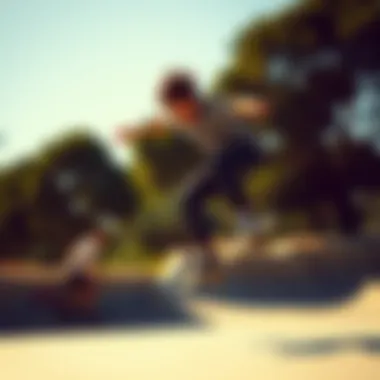
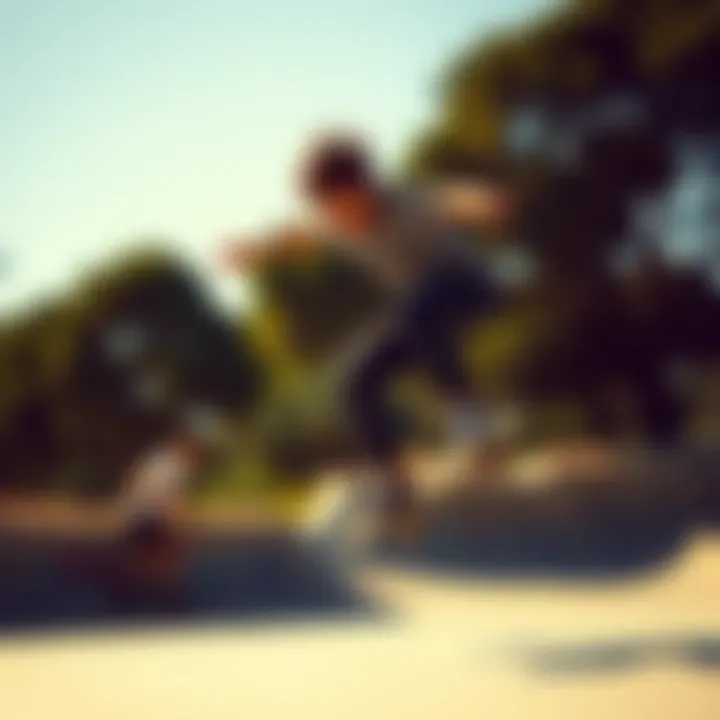
- Allocate Time: Allocate 30 minutes for warm-ups and drills and 30 for practicing tricks or exploring new areas.
- Adapt as Needed: As you improve, don't hesitate to tweak your schedule. Add more time for complex tricks or organize practice around local skate events.
Incorporating Drills and Exercises
Incorporating drills and exercises into your routine is where the rubber meets the road. These are tailored activities aimed at refining specific skills essential for skateboarding. It’s not just about the time spent on the board, but how that time is utilized.
Consider these drills:
- Balance Exercises: These can include riding on different surfaces, such as grass or gravel, to enhance your stability. Practicing ollies and getting comfortable with lifting the tail of the board also strengthens your core balance.
- Focus on Pushing and Stopping: Set up a course with cones to practice changing speed and direction. This will directly translate to your ability to navigate obstacles while on the move.
- Turning Techniques: Use a parking lot or flat surface to practice sharp turns and carving at different speeds. Understanding how your body weight shifts helps improve control.
By dedicating portions of your practice to such drills, you ensure that every moment spent on your board is aimed at making you a well-rounded skater. As many seasoned skaters can tell you, it’s those small improvements made in drills that compound over time to create a profound impact on overall skill — one trick can be the difference between a night spent nursing a sore ankle or the thrill of nailing your first kickflip.
Ultimately, remember that progress is a marathon, not a sprint. Be patient with yourself, and relish every small victory along the path!
"When you find joy in the process of practicing, the destination becomes a mere bonus on your journey."
For more tips on skateboarding practice routines, check out these resources: Wikipedia Skateboarding, Britannica Skateboard.
You can also connect with fellow skaters on platforms such as Reddit for community-driven advice.
Common Challenges and Solutions
In any endeavor, especially one as dynamic as skateboarding, facing challenges is a given. Acknowledging the common hurdles that beginners encounter equips them with a roadmap to navigate potential pitfalls. This section dives into two significant struggles area for skaters: frustration and the necessity of the right environment. Having a grasp on these issues can not only help in overcoming them but also transform them into learning opportunities.
Dealing with Frustration
Frustration is a universal experience, particularly when learning something new like skateboarding. The joy of gliding on a board can quickly turn sour when one finds difficulty in executing basic tricks or maintaining balance. This emotional rollercoaster can lead to self-doubt and a desire to give up, but here are some steps to manage that frustration:
- Set Achievable Milestones: It’s crucial to break down the learning curve into digestible parts. Instead of aiming to master a trick immediately, focus on smaller achievements, like simply pushing off smoother or landing your feet where they should be.
- Celebrate Small Wins: Each time you improve, no matter how minor, acknowledge it. This practice fosters a positive mindset.
- Find Support: Whether it’s friends, skate park regulars, or online communities, sharing experiences can ease the burden. A few encouraging words from fellow skaters can inspire you to tackle that next grind.
- Stay Aware of Progress: Keeping a journal or video log of your skating can provide perspective. Often, we don’t notice how much we’ve improved until we see it in black and white.
"Success isn't just about what you accomplish in your life; it's about what you inspire others to do."
Finding the Right Environment
The environment where one practices skateboarding is crucial. A supportive and safe space can enhance learning, while a chaotic or intimidating setting can magnify challenges. Here’s what to consider when scouting for suitable spots :
- Accessibility: Look for local parks or spaces that are easy to get to. If traveling takes too long, it may discourage practice.
- Community Vibe: Seek out parks that have a vibrant community. Watching more experienced skaters can provide insights and help in picking up tricks. Plus, it creates an encouraging atmosphere.
- Safety First: Always choose spaces that are well-maintained to reduce the risk of injury. Cracked pavement or obstacles can become hazards that lead to more frustration and less enjoyment.
- Flexibility of the Area: A park with diverse features allows for different skills levels and styles. Find places that cater to both beginner-friendly setups as well as places to challenge yourself once you gain confidence.
- Local resources: Engage with platforms like reddit.com where local skaters can share insights on the best spots to practice.
When you frame challenges not just as barriers but as gear shifts in your learning process, it transforms the ride into a richer experience of personal growth and skill enhancement in skateboarding.
Skateboarding Culture
Skateboarding culture is a vibrant tapestry that extends far beyond simply riding a board. It’s an amalgamation of art, music, fashion, and community, all woven together by a shared passion for skating. This cultural landscape informs how individuals connect with one another, shapes their identity, and influences trends far and wide. Understanding this culture can enhance one’s skateboarding journey, offering insights into values and norms that define this sport.
The History of Skateboarding
To truly appreciate skateboarding culture, one must delve into its roots. The origins can be traced back to the late 1940s and early 1950s when California surfers sought to mimic the ocean's waves on land. They fashioned their first boards from skateboard-like contraptions, paving the way for a unique style that combined aspects of surfing and traditional skating.
As the 1960s rolled around, skateboarding began to gain momentum with the help of various innovations, such as the introduction of polyurethane wheels. This leap in technology not only improved performance but also opened the door for more elaborate tricks and techniques.
By the late 1970s, skateboarding exploded into a world of its own, with skate parks popping up and competitions sparking interest nationwide. The legendary Z-Boys, a group of skaters from Santa Monica, made waves with their aggressive style, pushing boundaries and changing perceptions.
The 1980s brought a surge of media attention, thanks in no small part to the emergence of skateboard magazines like Thrasher and the loud call of punk rock soundtracks accompanying those gnarly tricks. This period highlighted not just the sport itself but the lifestyle surrounding it, which included wild fashion statements and a deep-rooted DIY ethic.
Fast forward to today, and skateboarding has become an Olympic sport, uniting a global community that transcends borders. Yet, despite its commercialization, the core values remain unchanged—creativity, freedom, and rebellion continue to define the culture.
Community and Influence
The heart of skateboarding culture lies in its community. It’s a melting pot of people from different walks of life, all united by a common pursuit. Local skate parks often serve as a gathering place where friendships are forged, skills are honed, and mentorship occurs. Beyond just skating, these communities foster a sense of belonging, helping individuals find their tribe among the chaos of life.
Moreover, skateboarding has historically influenced various other cultural realms—music, fashion, and even art. Bands that embrace the skate culture often gain traction within the skating community, while street artists frequently draw inspiration from skateboarding’s aesthetics. Events like street skating demonstrations or art shows showcase this blended cultural influence, promoting cross-pollination among various expressions of creativity.
Skateboarding also plays a significant role in advocating for social and environmental causes. Many skaters take to the streets to raise awareness for issues, including climate change, equitable access to skate resources, and social justice. The ethos of skateboarding encourages activism, motivating individuals to use their voice and platform for greater impact.
Community is about collaboration, not competition. It’s about supporting one another and empowering growth, not just on the board, but in our lives.
Integrating Skateboarding into Lifestyle
Integrating skateboarding into one’s lifestyle can be a game-changer, shaping not only physical fitness but also offering a unique personal journey. It’s not just about riding a board; it’s about adopting a mindset that endorses discipline, creativity, and community engagement. The real beauty of skateboarding lies in its ability to fit neatly into various lifestyles, making it appealing for surfers, sports enthusiasts, and even lifestyle bloggers who share their adventures.
Health Benefits of Skateboarding
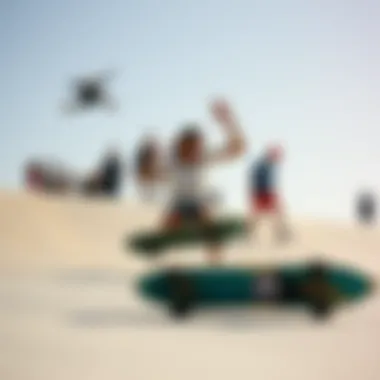
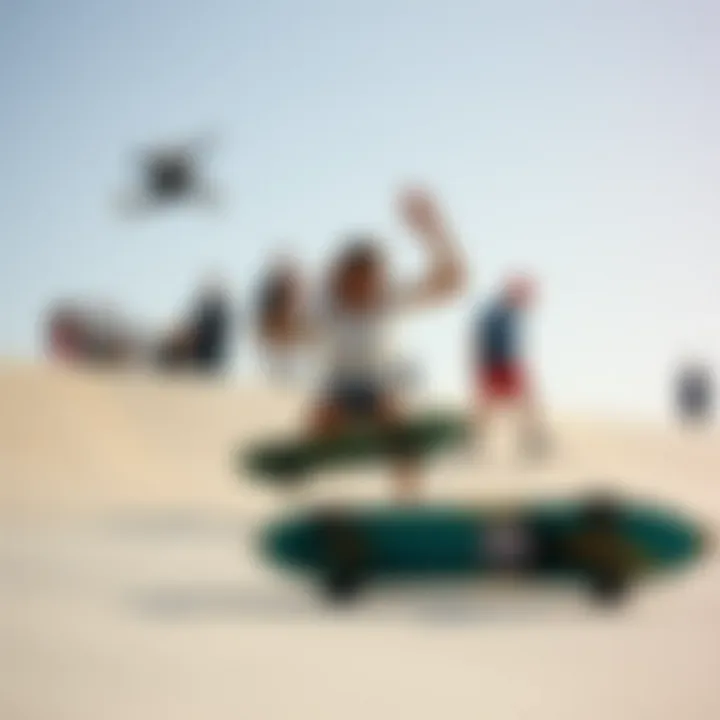
Skateboarding comes with a slew of health benefits that often go unnoticed. For starters, it’s a fantastic cardiovascular workout. When you carve and push on the board, your heart rate rises, burning calories and improving the overall health of your heart. Additionally, skateboarding helps to develop muscle groups that are often neglected in traditional workout regimes. Legs and core muscles get an intense workout, enhancing strength, endurance, and balance.
Engaging in this sport also directly contributes to mental well-being. Being on a board encourages focus, allowing skaters to enter a state of ‘flow’—a term used to describe being fully immersed in an activity. The mental gymnastics required in balancing, turning, and performing tricks serve as a natural stress reliever. Regular skate sessions can foster a sense of accomplishment, promoting confidence and resilience.
- Promotes Cardiovascular Fitness: Skateboarding is a great way to keep your heart healthy.
- Develops Core Strength: The balance and coordination needed strengthen the core, leading to better posture.
- Enhances Mental Health: Through focus and fun, it serves as a stress outlet, boosting your mood.
Environmental Considerations
Skateboarding is not just beneficial for the individual; it also has a positive ripple effect on the environment. By choosing a skateboard over a car for short trips, enthusiasts can significantly reduce their carbon footprint. This eco-friendly mode of transport promotes a more sustainable lifestyle, aligning with the values of many environmental advocates today.
Moreover, skateboarding encourages the use of local spaces like parks, which can lead to a stronger community focus on public spaces and facilities. With the increasing awareness of the need for green lifestyle choices, the skateboarding culture is paving the way for innovative skate parks that integrate natural elements. It’s about transforming urban landscapes into vibrant, interactive environments that enhance not just the sport, but the community as a whole.
"The skateboarding culture, by encouraging engagement with local spaces, helps cultivate a sense of ownership and responsibility for our environment."
- Sustainable Transport Option: Riding a skateboard for short distances reduces vehicle emissions.
- Community Engagement: Building and maintaining skate parks fosters local pride and responsibility.
- Promoting Green Spaces: Parks designed for skating contribute to vibrant urban areas, enhancing aesthetics and community interaction.
In summary, integrating skateboarding into everyday life goes beyond the sport; it promotes a healthy lifestyle and greater awareness of our impacts on the world around us. With numerous health benefits and a positive environmental impact, it indeed offers a rich tapestry of possibilities for personal and community growth.
Resources for Further Learning
In the realm of skateboarding, as with any skill, the path to mastery is greatly enhanced by utilizing a variety of learning resources. Understanding the landscape of available materials can sharpen your techniques, broaden your knowledge, and even inspire you through the experiences of others. For novice skaters, this framework serves not only to hone physical skills but also to heighten interest and enthusiasm for the sport. Here’s why engaging with resources for further learning is essential:
- Diverse Learning Modalities: Each individual learns differently. Some might grasp concepts more effectively through visual explanations, while others prefer textual guides. Resources like tutorials and community forums cater to these diverse preferences, guaranteeing that there’s something for everyone.
- Staying Up-to-Date: The skateboarding world continuously evolves, be it through new tricks, gear innovations, or shifts in cultural significance. Engaging with current resources ensures that you remain informed about recent developments and techniques, ultimately enhancing your riding experience.
- Community Building: Exploring various learning resources often leads skaters to communities where they can connect with like-minded individuals. This sense of belonging can be invaluable for motivation and support.
Whether you’re watching an instructional video on how to execute your first kickflip or diving into discussions on a forum about the best local parks, the right resources can propel your skateboarding proficiency forward.
Online Tutorials and Videos
In today’s digital age, online tutorials and videos have become a cornerstone for learning skateboarding. The convenience they offer cannot be overstated. Skills like ollies and grinds can be visually demonstrated, allowing you to understand execution through clear examples.
Benefits of Online Learning
- Visual Demonstrations: Seeing a trick performed correctly is often more beneficial than reading about it. Platforms like YouTube have countless channels dedicated to skateboarding techniques, some even run by professional skaters such as Tony Hawk or Nyjah Huston.
- Access Anytime: Unlike traditional classes, online tutorials are available at your convenience. This flexibility allows you to practice at your own pace, revisiting complex techniques as needed.
- Interactive Feedback: Some platforms allow for interactive tutorials where you can ask questions or even share videos for feedback from experienced skaters. This helps in identifying areas for improvement.
Recommended Resources:
- YouTube – Search for skateboarding channels like "Skateboarding Made Simple" or the official "Birdhouse Skateboards" channel.
- Skillshare – Offers classes focusing on skateboarding techniques and fitness.
"A picture is worth a thousand words, but a video is worth a thousand tricks."
Local Skateboarding Communities
Engaging with local skateboarding communities is another crucial aspect of developing your skills in this sport. The camaraderie and support found in these groups can be monumental in fostering not only technical proficiency but also lasting friendships.
Advantages of Local Communities
- Real-Time Interaction: Nothing beats the opportunity to learn directly from others. Local skaters often organize practice sessions, where the exchange of tips and feedback occurs in real time.
- Building Relationships: By joining local skateboarding groups, you create bonds with fellow enthusiasts. These connections can lead to lifelong friendships and even mentorships as you progress in your skills.
- Access to Events: Many communities host events and competitions that offer a chance to showcase your skills and get involved in local culture. These participatory experiences can inspire others and amplify your drive.
To find skateboarding communities near you, consider the following:
- Local Skate Centers: Visit skate parks or check bulletin boards for information about meet-ups.
- Social Media: Platforms like Facebook have groups dedicated to local skaters. Searching for keywords like "Skateboarding [Your City]" can yield fruitful results.
- Meetup.com: This site offers a searchable database to connect with like-minded individuals interested in skateboarding activities in your area.
Ending
As we wrap up this exploration into the world of skateboarding, it’s essential to take a moment to reflect on what this journey entails. The path to skateboarding proficiency is not merely about honing tricks or mastering difficult routes; it’s about personal growth, resilience, and discovering one’s limits. The journey of each skateboarder is unique, shaped by their experiences, challenges, and triumphs.
Reflecting on Your Progress
Seeing how far you’ve come is crucial. Take a moment to step back and acknowledge your achievements, no matter how small they might seem. Whether you’re nailing a new trick, feeling more stable on your board, or simply enjoying the thrill of riding, these moments are foundational. Keeping a journal or a vlog can help capture these milestones.
- What was your first successful trick?
- When did you start feeling comfortable at higher speeds?
- How do you feel about tackling new skate parks now compared to when you began?
Each of these reflections highlights growth. But remember, the road is long, and every fall teaches a valuable lesson. Don’t be too hard on yourself when progress feels stagnant. Sometimes, just enjoying a ride and socializing with fellow skaters is just as vital.
Setting Future Objectives
Now, looking forward is equally important. Setting clear objectives can provide the motivation needed to keep pushing your limits. Think about what you want to achieve next month, or even the next year. Here are some ideas:
- Master a new trick: Focus on one trick you’ve been wanting to learn, like a kickflip or an ollie.
- Join a local skateboarding group: Connect with others to learn and feel inspired.
- Participate in a local competition: Test your skills against others in a friendly setting.
- Focus on fitness: Incorporate strength and balance training into your routine.
Setting goals not only keeps you motivated but also helps you to stay accountable. Make sure your objectives are SMART—Specific, Measurable, Achievable, Relevant, and Time-bound.
Ultimately, your journey in skateboarding is a mix of practice, patience, and community. Keep enjoying every moment, as the ride is just as important as the destination.
"Skateboarding is about exploring boundaries, both external and internal, while building a culture of respect and camaraderie."
In this conclusion, taking stock of your progress and setting aspirations is not just good practice; it's essential in developing not only as a skateboarder but as an individual. So grab your board, keep pushing through those challenges, and remember that each ride builds your future.
For further resources, consider checking Skateboarding.com, Reddit - Skateboarding Community, or local skate shops that often host workshops and events.
